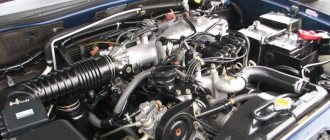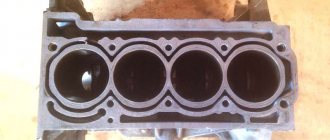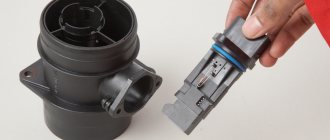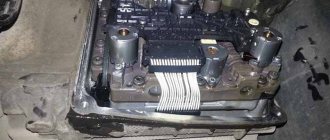The emergence of a new generation of Mitsubishi Pajero has given rise to a lot of controversy. What is this? A completely new model or a deep modernization of the previous one? And yet, this is the result of modernization of the third generation SUV. The guesses are confirmed by the external and technical similarity of the cars, as well as common “sores” and the same service life of units and systems.
The fourth generation Pajero went into production in 2006. In 2012, a restyled version of the SUV was introduced. Production of the model ended in 2021.
Engines
Under the hood of the fourth Pajero there are naturally aspirated gasoline engines with a displacement of 3.0 liters (6G72 / 178 hp) and 3.8 liters (6G75 / 250 hp), as well as a turbodiesel with a capacity of 3.2 liters (4D41 / 170 hp and 200 hp since 2009). In Pajero 4 imported from the Gulf countries, you can find 3.8 liter petrol (very rare) and 3.5 liter (6G74 / 202 hp).
The 3-liter gasoline unit in the line of engines has the most innocent biography. It is characterized as the simplest, most reliable and durable. In addition, it easily digests 92 gasoline. True, the dynamics of an SUV with such an engine leaves much to be desired, but off-road it is not so important.
The 3.5 liter petrol engine, in terms of reliability, is also not considered capricious. But the impressive mass for 202 “horses” is still not enough.
The flagship 3.8 liter with MIVEC variable valve timing system gives the Mitsubishi Pajero 4 decent dynamics. The engine is generally reliable, with no surprises. But there was one unpleasant moment.
During the period from February 1 to May 21, 2008, a software failure occurred on the assembly line of TR series motors. As a result, the robot installed crankshaft bearings that were smaller than the required size. Consequences? Owner complaints about knocking in the engine and replacement of the “short block” or the entire engine under warranty. The cost of a short block is about 110 – 120 thousand rubles. More often, the problem appeared after 10-20 thousand km, but it could also appear later - after 40-70 thousand km. Symptoms of the disease were knocking noises that were noticeable when the speed increased above 1000-1500 rpm (similar to the sound of a slashing exhaust).
Oddly enough, some 2007 models with a mileage of more than 100,000 km ended up on the operating table of engine specialists with similar symptoms. The diagnosis is oil starvation and cranking of the crankshaft liners. It was possible to bring the engine back to life after replacing the crankshaft and bearings.
After 80-120 thousand km, the operation of the MIVEC system could be accompanied by excessive noise/rattling, noticeable as the speed increases. This is a feature of the system, and the noise does not progress with increasing mileage.
Several examples with the 3.8 liter engine fell victim to the intake manifold flaps - they got into the cylinders due to loose screws. This problem is familiar to owners of the third generation Pajero with the same engine. As a preventative measure, the screws securing the dampers can be sealed with thread sealant. A new modernized intake manifold costs about 19,000 rubles.
With high mileage, the flagship 3.8 may begin to consume a lot of engine oil. Often it is enough to update the valve stem seals. In extreme cases, you have to change the stuck rings (50-70 thousand rubles).
Gasoline units have a timing belt drive with a recommended replacement interval of 90 thousand km. A new timing belt kit will cost 10-12 thousand rubles, and the work to replace it will cost about 6-10 thousand rubles.
With a mileage of more than 120-150 thousand km, the radiator may leak. The original costs 20-25 thousand rubles, the analogue is cheaper - 3-5 thousand rubles. Catalysts serve over 150-200 thousand km.
Diesel engine
The 4D41 turbodiesel is demanding on the quality of diesel fuel. The first problems may appear after 60-100 thousand km. The reason is a failure of the high-pressure injection pump valve (6,000 rubles) or soot-clogged tubes connecting the sensor on the fuel filter bracket to the intake manifold. At the same time, Check and ASC OFF lights up, traction decreases, and when changing gears, the transmission jerks.
Injectors, as a rule, run over 200,000 km. The cost of a new nozzle is 26-28 thousand rubles.
The EGR valve may need to be cleaned a little earlier. Dealers charge about 13,000 rubles for this procedure. A new valve can be found for 8-10 thousand rubles.
With a mileage of more than 120-150 thousand km, the upper stabilizer and chain tensioner often gave up (2-3 thousand rubles). I had to shell out about 15,000 rubles for a replacement.
Hello, diesel: test drive Mitsubishi Pajero Sport 2.4 DID
There are few of them left
How did the unforgettable Bulat Shalvovich sing: “There are few of them left, and this is our pain”? Well, that’s not exactly how he sang, I agree, but the fact remains: there are only a few of them, in the sense of real SUVs, left on the market, one, two, and there are too many... But for those who need neither a crossover nor a premium SUV, and it is a hard worker for all occasions; in our country there are still plenty of unkempt destinations and evergreen tomatoes. Therefore, the appearance of the new Pajero Sport was received quite favorably. Only this benevolence turned out to be somewhat platonic and theoretical: in two quarters of 2016 and four months of 2017, a little more than 700 cars were sold. Why?
There are quite a few reasons, but one of them was clearly the lack of a diesel version on the market. It is worth recalling that for every one sold Pajero Sport of the previous generation, equipped with a petrol V6, there were 9 diesel ones... In July last year, Mitsubishi employees swore and swore that there would certainly be a diesel engine, and now, finally, their promises have come true. So there is reason to assume that if the above-mentioned ratio continues for the third generation of the model with the factory index QE, then sales of the brand will explode upward, like an interceptor fighter scrambled on alert. Or won't they rush? What will the diesel Pan Sportsman be like in business and in everyday life? Until you try, you won't understand...
Design against cross-country ability
I must say that at the first meeting the new Pajero Sport made a mixed impression on me. On the one hand, the car looks really impressive. Ahead are predatory “mandibles” with chrome edging, muscular, clearly defined bumps on the wheel arches, an energetic profile, a boldly rising sill line, triangles of rear lights flowing onto the wings, continuing with a sharp stamping, and symmetrical stamping on the front fender, an abundance of chrome parts...
Both the front and rear lighting equipment are distinguished by intricate shapes. Especially the rear one, with the blade flowing down to the level of the bumper. Yes, the third Sport is no longer just a hard worker, made by bolting a simple station wagon body onto a light truck chassis. And yet the design of this model is very ambiguous. For my taste it is too pretentious, and there are too many individual details.
But this is not even important... Mitsubishi Pajero Sport is essentially a classic frame SUV, that is, a vehicle that combines sufficient comfort with utilitarianism and the ability to overcome serious off-road obstacles. Now tell me, hand on heart, will it be easy to decide to use all this complex Dinamic Shield (this is the name that Japanese designers came up with to describe the geometry of the front end) in order, for example, to break a road through bushes or demolish the edge of some ditch? Or this question: where can I find a plane for attaching the winch fairlead? After all, an SUV is a car that will get stuck in places that a crossover simply cannot reach. So if you start using the Pajero Sport’s cross-country ability to its fullest, you will certainly find yourself in such abysses that you cannot do without a winch. Now you have realized all this, you have matured your readiness to go through seven circles of administrative hell to make changes to the PTS... But where to put the winch?
Or take the beautiful running boards that are included as standard. In the city they will certainly be both appropriate and useful. Here you are helping some petite young lady in a miniskirt climb into the cabin: “Here, dear, on the step, let me help you...” And “in the pampas”? Somehow, I seriously doubt that these running boards can perform the function of power protection of thresholds, but they worsen the geometric cross-country ability, and quite noticeably.
Curb weight
2,095 kg
Well, with my height, the footrests only hinder me from getting into the cabin: after all, the frame of the Pajero Sport has a quite progressive shape with ascending front and rear branches, so the driver’s seat cushions are not located too high. And after mud baths, you generally need to be wary of them: getting your trousers dirty on their edges is a piece of cake.
Smartphone positioning problem
There are certain questions regarding the organization of the interior space of the car. Even at the first meeting with the SUV, I noted that it was a bit cramped for me in the driver’s seat. You sit down in a chair, and a line from Vysotsky begins to spin in your head: “the orderlies rushed in and fixed us down”...
1 / 2
2 / 2
The Russian representative office of Mitsubishi never tires of repeating: “we do not position our cars as premium!” Well, premium, not premium, but you can’t call the Pajero Sport “budget” anymore. The price of the Ultimate configuration is very close to the 3 million ruble mark, and in the case of the diesel version it exceeds it. And here the question arises: at this price, are you ready to put up with the loud, drum-like hard plastic of the front panel?
1 / 4
2 / 4
3 / 4
4 / 4
A truly budget model would be easily forgiven for the lack of places to place all sorts of little things on the road, primarily phones, and the insufficient number of 12-volt sockets and USB sockets. Yes, the new touchscreen media system has built-in Apple CarPlay and Android Auto apps, and you can integrate your smartphone and enjoy a ton of different services. But where should we put this smartphone? I couldn’t find any suitable place in the front cabin, other than to put it in the cup holder.
1 / 2
2 / 2
The second row of seats is quite spacious, but its inhabitants are not entitled to any additional amenities. Even controlled air ducts appeared only on cars of the 2017 model year. But there were no 12-volt sockets, no USB slots for connecting all sorts of gadgets.
1 / 4
2 / 4
3 / 4
4 / 4
I want to see it up close!
But what raised the most questions for me was the layout of the driver’s seat and visibility. No, in the city and on the highway there are no problems (although with my height of 182 centimeters I had to move the seat back all the way), but once you go to the “pampas”...
Trunk volume
673 / 1,624 liters
The fact is that Pajero Sport belongs to the “low” SUVs with a “semi-commander”, almost car-like seating position. The result is a massive hood that covers everything directly in front of the car. The fact that on asphalt objects located at road level are hidden from view already 20-30 meters away does not bother anyone. But off-road, you want to see what is directly in front of the bumper! And it’s not just that you want it, sometimes it’s vitally necessary. Of course, I tried to raise the seat higher, but my head stuck into the roof, and the seat itself shifted forward. Moving the steering wheel, which is now adjustable both in angle and reach, did not help either. We can only hope for a 360-degree video viewing system, which we still need to learn to understand.
"Superherring" as a masterpiece
The off-road platform itself is beyond doubt. The Pajero Sport arsenal has huge travel and the highest energy-intensive suspensions, mechanical locking of the rear axle and, of course, the Super Select II transmission with a solid reduction gear in the transfer case.
Super Select, or “super herring” in Jeeper jargon, is a real masterpiece of engineering, a box that makes it possible to combine the advantages of a scheme with a forced front axle and permanent all-wheel drive with a center differential. The only thing missing was a high-torque diesel engine, but it didn’t keep us waiting too long. So if we, in fact, already talked about all the innovations that appeared in the third Pajero Sport last summer , now God himself ordered us to focus on the behavioral features of the diesel version.
Moreover, the organizers of the test drive laid out a really interesting route, which included high-speed highways, narrow mountain serpentines, and quite difficult sections of mountain off-road. In addition, we had both diesel and gasoline cars at our disposal. In general, it was possible to compare your sensations, if not in the same areas, then at least under very similar conditions.
Asphalt round
Let's start with asphalt, because Pajero Sport owners, as a rule, live not in distant cordons in abandoned forest areas, but in cities. Accordingly, their off-road extreme usually begins with fairly long trips, first around the city, and then along country roads.
In these conditions, of course, the petrol V6 remains superior. It seems that the difference in dynamics is not so great: a diesel engine accelerates a two-ton vehicle to “hundreds” in 12.3 seconds, and a three-liter V6 in 11.7, but subjectively this is felt very acutely. However, at city speeds this difference is minimal, and the fact that the gasoline engine is still somewhat more responsive is compensated by the excess torque of the compression-ignition engine, which allows you to accelerate without downshifting.
The car maneuvers well in cramped conditions: its turning radius is only 5.6 meters. However, it is worth considering that even on a second category road (the width of the roadway is 7.5 meters, plus meter-long shoulders), you will not be able to turn around in one go.
Fuel tank volume
70 liters
In parking lots, a 360-degree video view with dynamic markings is very helpful, and when changing lanes on multi-lane highways, the BSW system (Blind Spot Warning, a warning about the presence of objects in blind spots). The sensors for this system are clearly visible on the outer edges of the rear bumper. The Forward Collision Mitigation System (FCM) does not remain idle: it brakes the Pajero Sport as you would expect from a heavy and inert car, namely with some laziness.
A much greater difference in the behavior of the versions is felt on country roads, especially two-lane ones. Overtaking on Caucasian serpentines is generally not easy, even if you are driving a car with a sporty character, but overtaking in a diesel Pajero Sport requires special skill.
Average fuel consumption per 100 km
8 liters
And here it’s not enough to just switch to manual gear shifting: you need to take into account that the “red zone” begins at around 4000 rpm. Accordingly, it is worth letting the overtaken truck go at least 50-60 meters, wait a moment, shift down a couple of gears, and then, during acceleration, shift up again. Actually, an eight-speed automatic would do approximately the same thing, but with an even greater time delay, and downshifting on kickdown also does not happen instantly. In the case of a gasoline engine, some delays are also observed, but the engine itself is still more responsive, and it spins up to 5-6 thousand revolutions without any problems, so overtaking through oncoming traffic is still somewhat easier.
And what I really like is the sound insulation, both in the “lighter” and in the version with a heavy fuel engine.
We say “diesel”, we mean “extreme”
But as soon as you turn from asphalt to mountain dirt roads, the picture changes exactly the opposite. On climbs that the diesel Pajero Sport simply doesn’t notice, the transmission of a gasoline car still needs to shift down a couple of gears. Where you drive in a diesel car in 4H or, in extreme cases, 4HLc mode, that is, with the Torsen center differential locked, in a gasoline car it is better to engage a lower gear, otherwise even on small inclines you will have to turn the engine, and the wheels will start to slip. Well, on steep descents, the diesel version brakes the engine much more effectively: even in very extreme places you can get by with a lower gear and switching the gearbox to manual mode. And then it’s up to you: if you want to go down quickly, choose second gear, if you want to completely sneak, choose first gear.
1 / 2
2 / 2
On a car with a gasoline V6, it is better to turn on the special hill descent mode. By the way, for long-distance travel with elements of extreme sports, the diesel version is also much better suited, primarily due to its much greater fuel autonomy. The on-board computer of the gasoline car dispassionately recorded that during off-road exercises, consumption exceeded 30 liters per 100 km, while for the diesel version this figure did not exceed 12 liters.
1 / 3
2 / 3
3 / 3
I also appreciated the work of the electronic auxiliary modes. I actually like the Japanese approach to this issue. While the British engineers, in the first system of this kind, entrusted electronics with a lot, including locking the center and cross-axle differentials, the Japanese left only the operating modes of the box and the engine response to the gas pedal under the control of artificial intelligence. Well, and the ESP operating mode, of course.
1 / 2
2 / 2
Clearance
218 mm
Indeed, in the “gravel” mode the stabilization works quite actively, but in the “rocks” mode it is simply turned off. In the “snow/mud” mode, you can most clearly feel how much longer the gas pedal becomes. In general, these are useful modes, although in Pajero Sport they are purely auxiliary. For example, the driver is asked to decide on the issue of locking the rear differential independently. On the proposed route, I never needed the blocking, although in one place, while climbing a stone “stairs,” the car got into a diagonal hanging situation. I didn’t skid, rolled back about a meter and a half and decided that I’d try a different trajectory, if the car didn’t go along it, then I’d be stuck in the blocking. Let's go...
Where are the wheels pointing?
In general, as you would expect, the Pajero Sport feels very confident off-road, in mud, on rocks, and in fords. Yes, he doesn’t like deep ruts, and on the terrain you need to be very careful: you can easily hit those same running boards against some hillock, even to the point of tearing off those same running boards. In particular, for this reason, the situation with not very good forward-down visibility really bothered me.
1 / 5
2 / 5
3 / 5
4 / 5
5 / 5
It would also be nice to supplement the transmission status icon, which is displayed on a small display located on the dashboard, with information about the steering angle of the front wheels. On asphalt, you can immediately feel the angle of rotation of the wheels, but in mud, it’s not uncommon for the car to seem to be driving straight, but your steering wheel is turned to the side, and in the wrong direction. On the radio they shout “Steering wheel left”, you turn the steering wheel half a turn, and again they shout “Left!” To the left! It turns out that it’s still a full turn to “zero”, and one and a half to the desired position...
1 / 5
2 / 5
3 / 5
4 / 5
5 / 5
In principle, you can navigate along the lines of dynamic markings in the picture of all-round cameras, but the large display is still not directly in front of your eyes, but above the center console, and to look at it, you need to take your eyes off the road (although in this case the “road” " - this is the place where you are going to pass). I was also very pleased that the 2017 model year cars were equipped with an additional steering damper. Now, both on “fast” bumpy dirt roads and on rocky climbs, the “recoil” to the steering wheel has been reduced to quite acceptable levels.
1 / 3
2 / 3
3 / 3
They are not competitors, but...
In general, I liked everything - both the car and the route. And even though the Pajero Sport has real shortcomings, it’s good that it exists, and that there is reason to hope that the class of real SUVs will not become history. But will the third Pajero Sport be able to repeat the success of the second? To be honest, I don’t know yet... Because a car of this kind is inherently utilitarian. It is needed by those who like to relax in nature, and in places that are very difficult to reach, or by those who have to travel a lot on very bad roads on business. But for many people in this category, the Pajero Sport will still be too expensive, and they would rather put up with the lack of many nice options, but buy a pickup truck with the same engine and transmission.
Mitsubishi Pajero Sport 2.4 DID
Brief technical specifications
Dimensions (L x W x H): 4,785 x 1,815 x 1,805 mm Engine: diesel DI-D, 2.4 l, 181 hp, 430 Nm Transmission: automatic transmission, 8-speed Drive: four-wheel, multi-mode Super Select II Acceleration to 100 km/h: 12.3 sec Top speed: 180 km/h
But how many of those who are willing to pay 2.5 - 3 million rubles for a car need such serious off-road capabilities? At the same time, it may well seem to them not smooth enough on the move, poorly controlled, not very dynamic... And this category will most likely look towards large crossovers, which, of course, are not even close to the Pajero Sport in terms of cross-country ability, but easily outperform it in terms of cross-country ability. equipment and road manners. Plus, in terms of prestige, Pajero Sport is difficult to compete with similar models from other brands, especially premium ones. The Pajero, which is gone but is preparing for a comeback, has a chance to compete even with SUVs of premium brands: behind it is wild success and cult status, earned in the last decade of the past century. And Pajero Sport has always been a hard worker. But let's see. The Russian market sometimes plays tricks like this...
You will like the Mitsubishi Pajero Sport 2.4 DID if:
- Your previous car is a second generation Pajero Sport;
- The phrase “opening of the season” for you means exclusively the opening of the hunting season for a particular type of game;
- From time to time you feel the urge to take a break from people - so you bought a house in an abandoned village somewhere in the middle of nowhere.
You won't like the Mitsubishi Pajero Sport 2.4 DID if:
- You don't understand how a three million car can have a hard front panel;
- Your spouse prefers to ride in the back seat, but hates the shaking;
- The sight of the side lights of a truck crawling ahead affects you like a red rag on a bull.
Transmission
Pajero IV gearboxes are reliable, and there are no complaints about them.
“Automatic” requires an oil change with a filter change every 60-90 thousand km.
Some owners note the appearance of shocks in a warm automatic transmission when moving from 3rd to 4th gear and back (usually after 100-150 thousand km). These symptoms do not develop and no malfunctions occur.
After 150-200 thousand km, an automatic transmission inhibitor (selector position sensor) may require attention. Usually it is enough to clean and lubricate the sensor. Less often you have to buy a new one (3-6 thousand rubles).
The “signature feature” of the Mitsubishi Pajero is the cardan play in the rear gearbox. At the same time, when you reset or press the gas, a knock is heard. The disease is acoustic and does not affect the durability of the transmission. To eliminate the knocking, you will need to replace the rear gearbox and driveshaft, which is very expensive. And there is no guarantee that after 20-30 thousand km the knocking will not appear again.
Over time, the rear gearbox begins to howl. But again there is no reason to worry - another feature.
The combination of ASC OFF, ESP signals and a flashing transfer case in most cases is the result of a drop in battery voltage.
The front gearbox is quite strong, but still some owners managed to “put it down” on hard “off-road”.
Sometimes the front-wheel drive sensor fails. The original is available for 7,000 rubles, and the analogue - for 1-3 thousand rubles.
Owners of new Mitsubishi Pajero 4 often noted vibration during acceleration, which disappeared after 10-30 thousand km. This is how the transmission units were worn in.
On older cars, it is periodically necessary to repair leaks from the transmission due to worn seals (300-800 rubles).
Generation 2
The first generation turned out to be very successful - during 1989 to 1990 alone, the Japanese produced more than 300 thousand cars. At the peak of its glory, Pajero entered its second generation. Now the cars have become larger, have a different body, and most importantly, they have not adopted the shortcomings of previous models.
Many engines from the first generation migrated to the second, plus new power plants appeared.
| Name | Number of cylinders | Number of valves | volume, m3 | Power, hp | Torque, Nm |
| 6G72 SOHC | 6 | 12 | 2.972 | 150 | 230 |
| 6G72 SOHC | 6 | 24 | 2.972 | 181 | 265 |
| 6G74 SOHC | 6 | 24 | 3.497 | 194 | 316 |
| 6G74 DOHC | 6 | 24 | 3.497 | 208 | 324 |
| 6G74 DOHC GDI | 6 | 24 | 3.497 | 245 | 343 |
| 6G74 DOHC MIVEC | 6 | 24 | 3.497 | 280 | 348 |
| 4D56 | 4 | 8 | 2.476 | 105 | 240 |
| 4D56T | 4 | 8 | 2.835 | 125 | 294 |
| 4M40 EFI | 4 | 8 | 2.835 | 140 | 314 |
| 4G54 | 4 | 8 | 2.555 | 103 | 196 |
| 4G64 | 4 | 8 | 2.350 | 112 |
In the second generation, 3-liter engines with the SOHS system, 12 valves and electronic fuel mixture distribution technology appeared. A 2.5-liter diesel unit also appeared with a new cooling system and Super Select 4WD technology, thanks to which the driver could choose the type of drive while on the move - at speeds of up to 100 km/h. Plus, for the first time in Japanese cars, a new multi-mode ABS system was used.
Mitsubishi Pajero was produced from 1991 to 1999. By the way, in 1997 they carried out a restyling, during which the design and power plants were changed. In particular, instead of the 6G74 with the DOHC MPI system, they began to use the 6G74 DOHC GDI, updated the transmission and added an automatic 5-speed gearbox for the 3.5-liter internal combustion engine, and a 4-speed for the 2.8-liter engine.
Chassis
The first suspension element that needs to be replaced is the front stabilizer bar bushings. Their service life is 25-40 thousand km. In addition, they are often a source of squeaking in the front suspension. Stabilizer struts last a little longer - 50-70 thousand km. Bushings and struts of the rear stabilizer last more than 120-150 thousand km.
Wheel bearings are sold out after 100-150 thousand km. For the original hub you will have to pay about 14,000 rubles, and for an analogue - about 3-8 thousand rubles. For work in the service they will ask about 2500 rubles.
The front shock absorbers of Pajero 4 last more than 80-100 thousand km, the rear ones - more than 100-120 thousand km. Often the silent blocks in the front shock absorbers give out before the shock absorber itself. In order not to change the shock absorber (3-7 thousand rubles), you can get by by repressing the silent block.
Ball joints of the front levers reach up to 150-180 thousand km (500-3000 rubles), and silent blocks of the front levers - up to 150-200 thousand km (from 500 rubles for an analogue). The ball joints and silent blocks of the rear levers take approximately the same amount of time to take care of.
Soured adjusting bolts are a common surprise when trying to adjust wheel alignment on cars older than 3-4 years. The surprise begins with the third Pajero. It’s good if the bolts have soured at acceptable wheel alignment angles. If not, then first you can try to “soak” the soured bolts. Did not help? This means you will have to cut the bolts. To avoid surprises in the future, it is better to lubricate the adjusting bolts. This procedure at dealers, together with adjustment, will cost 12-14 thousand rubles, in third-party services it is cheaper - about 5-7 thousand rubles.
There are alarming cases of loss of control over the car and rollover at speed due to the destruction of the rear wheel alignment arm. Fortunately, the incidents are isolated so far. The defect is typical for the levers of the well-known and respected spare parts manufacturer Masuma. Perhaps the installed levers were fake.
The steering rack no, no, and even begins to “clank” after 100-150 thousand km. A new original rack costs about 100,000 rubles, and an analogue one costs 18-22 thousand rubles. Rebuilding the rack will require about 14-16 thousand rubles. Most often, the reason for the knocking is the play of the “glass” that presses the worm shaft to the rack. Diagnosed by play in the steering rod in the up and down direction. Tightening the slats will help improve the situation for a short time.
Over time, a squeak appears in the area of the steering shaft boot on the floor. After lubricating the unit, the squeak disappears.
Runout of brake discs with a mileage of more than 20-30 thousand km is a common phenomenon, well known to owners of Pajero 3. Sometimes it is possible to get rid of the runout after resurfacing the discs. But there is no guarantee that it will not appear again soon. It is better to replace the brake discs with higher quality analogues.
After 100-120 thousand km, it would not be superfluous to inspect the calipers, which, most likely, are already beginning to jam due to souring of the guides. The repair kit is not expensive - about 1000 rubles.
Another common problem is ringing parking brake pads. It can be treated by installing springs from the parking brake of the previous Pajero.
Due to chafing of the ABS wiring insulation, the rear left drive boot may cause the ABS, ASC OFF and “slippery road” indicators to light up.
With a mileage of more than 100-120 thousand km, failure of the brake accumulator occurred. A new one cost about 5-6 thousand rubles.
Diesel engines
Motor 4D56
This engine has proven itself on other Mitsubishi models - on the classic Pajero and L200, as well as on the Mitsubishi Delica. The design of this engine turned out to be so successful that its production is still ongoing (under license from Mitsubishi), but under the auspices of the Korean manufacturer Hyundai, the 4D56, which was redesigned by the Koreans, received a different marking - D4BH/D4BF.
The 4D56 device is an in-line four-cylinder cast iron block with a volume of 2.5 liters, the ratio of the piston stroke (95mm) to the cylinder diameter (91.1mm) is approximately the same (the so-called “square”), which is generally often found among Japanese engineers. In practice, “square” engines of Japanese origin (such as, for example, Toyota JZ series engines) show a good balance of power and reliability. As mentioned above, the 4D56 block is made of cast iron; “dry” liners are pressed into it and do not need to be removed when performing major repairs. The crankshaft in the block rests on 5 bearings.
Also among the features of the engine, it is worth noting the presence of balancer shafts in the cylinder block, which are driven through the timing mechanism. The use of balancer shafts is due to high loads on the crankshaft and in the absence of such additional shafts there is a risk of accelerated wear of the crankshaft or its fracture.
The cylinder head on the 4D56 internal combustion engine is made of aluminum (with vortex combustion chambers) and cannot boast of great reliability; cases of cracks appearing in the cylinder head itself are not uncommon.
Initially, the diesel engine did not have a turbine, but since 1991, all produced engines began to be equipped with turbocharging, which also required lowering the compression ratio and adding intermediate air cooling. The number of this internal combustion engine is 4D65T, and it is this that has become one of the most popular power units installed on Pajero Sport. On the first versions of the 4D65T, a mechanical injection pump (high pressure fuel pump) was installed. Difference in engine power:
Motor 4M40
Along with the release of 4D56, Mitsubishi production facilities also produced a power unit under the symbol 4M40. Initially, this engine was conceived as a more technologically advanced alternative to the classic 4D56, but in practice it turned out that the 4M40 is just another repetition of the 4D56. There are fewer technological “flaws” and the power even increased due to an increase in volume to 2.8 liters, but there are still a lot of problems from its predecessor.
The design of the 4M40 was essentially inherited from its predecessor - again a four-cylinder cast-iron block, with “dry” ceramic-coated liners. The volume was increased according to a standard scheme close to “square” engines, the cylinder diameter was 95 mm, the piston stroke was 100 mm. The crankshaft is steel, resting on 5 bearings. The cylinder head is aluminum, 8-valve with vortex combustion chambers (CV) and is just as problematic; cracks in the cylinder head are common on the 4M40. The design difference on the 4M40 compared to the 4D56 was the timing drive; on this engine it is carried out through a double-row chain; the balancer shafts are also driven through this chain, and not a belt as on the 4D56.
In the first versions, the 4M40 was equipped with a mechanical injection pump, a turbine and an intermediate intercooler; the power of this unit was 125 hp. Since 1996, the mechanical injection pump was replaced by electronic injection (EFI) and the power of the power unit increased to 140 hp.
Motor 4M41
4M41 is nothing more than an updated version of 4M40. Despite the fact that the previous model had many technological problems, Mitsubishi engineers decided to modify the existing 4M40 engine, and this is how the newly-made 4-cylinder diesel engine 4M41 with a volume of 3.2 liters was obtained.
During the modifications, changes affected many components, in particular the cylinder block, the cylinder diameter was increased to 98.5 mm, the piston stroke also increased, on 4M41 it is 105 mm. The design of the timing mechanism remains the same, with the timing drive via a chain. The main difference between the 4M41 and the 4M40 is a more technologically advanced 16-valve cylinder head on classic mechanical valve lifters.
The diesel 4M41 turned out to be more balanced, unlike the 4M40, some problems associated with the cooling system were solved, but the common problem of cracking cylinder heads, which has been a thread since the 4G54 internal combustion engine, has not gone away. In general, if we compare 4M40 and 4M41, the second one turned out to be even more economical due to the large volume of 3.2 liters and an updated injection pump. The maximum effective torque of the 4M41 remained at the same level of 2000 rpm, but the thrust increased significantly.
Other problems and malfunctions
The paintwork of the Mitsubishi Pajero 4 body is quite soft and not resistant to external influences. Over time, many scratches and chips are discovered, which in addition begin to bloom.
More often, the first “spiders” appear on the trunk door and the bar separating the glass of the rear door. Small pockets of corrosion also appear under the door seals on the window frames. This is another legacy of the third Pajero. The hub nut caps and spare wheel cover frame are also susceptible to corrosion (over 13,000 rubles).
The fuel tank cannot resist the “brown plague”. This is all thanks to the dirt that accumulates in the space between the bottom of the tank and its protection. A new tank is available for an amount from 10 to 30 thousand rubles. The replacement work is estimated at approximately 7,000 rubles.
Many Pajero IV owners note insufficient body rigidity. This is confirmed by the abrasions of door openings that appear on cars older than 4-6 years. In addition, the doors “slam” on potholes, and dust gets into the interior through the seals. Installing an additional seal or strengthening the original one will help improve the situation.
Over time, corrosion occurs on the rear wheel arches in areas of wear.
Another “design feature” is the dangling right rear light. The reason is the development of the flashlight mounting on the “piston”.
A huge windshield often attracts stones like a magnet. The cost of updating the windshield will be about 9,000 rubles. Sometimes in wet weather the glass of fog lights breaks.
On Pajero older than 5-6 years, equipped with a sunroof, problems appear with the drive mechanism. It is sold only complete with hatch. The mechanism can be purchased separately at auto wrecking yards for 7-8 thousand rubles.
With a mileage of more than 100-130 thousand km, the linkage of the rear headlight range control sensor often requires replacement due to a soured joint. The cost of traction is about 1-2 thousand rubles.
With a mileage of more than 60-90 thousand km, it begins to creak, and after 100-120 thousand km, the front windshield wiper trapezoid may fail (5-6 thousand rubles). The rear windshield wiper does its job extremely poorly. After a small modernization of the rear link of the Russian VAZ-2111 and installing it instead of the original one, the rear window becomes cleaner.
The plastic trim of the interior soon begins to creak annoyingly. Common areas include panels around the gearshift levers, trim above the glove compartment lid, and air duct grilles.
Power front seats may no longer adjust fore and aft due to wear on the motor brushes. Over time, the front seats begin to creak. The leather trim of the seats quickly loses its “marketable” appearance, and the side of the driver’s seat even breaks. Soon the leather on the steering wheel goes bald.
On Pajero 4 older than 5-6 years, the steering column cable often frays. In this case, the sound signal stops working and the airbag malfunction lamp comes on. A new original train costs about 9,000 rubles. The Chinese analogue can be found on the Internet for 1000 rubles.
Problems with interior cooling can be caused by a radiator clogged with “road dust” or rotten rear air conditioner pipes. The aggressive road environment kills them in 3-6 years. Many, deciding to save money, simply turn off the rear circuit (5-8 thousand rubles). You can restore the rear tubes for 13-17 thousand rubles. The best option is special hoses that last longer - about 20,000 rubles.
At the same time, the rear row heater pipes also suffer.
The electric cooling fan of the air conditioner radiator can also fail (21,000 rubles for the original or 8,000 for an analogue).
Electricians, as a rule, do not cause any problems.
4N15 diesel engine Mitsubishi Pajero 3
The third generation of popular SUVs of the Japanese concern is equipped with 4N15 diesel engines. This is a new generation of power units. Among their design features:
- R4 architecture;
- aluminum cylinder block with dry cast iron liners;
- working volume – 2442 cubic meters. cm;
- maximum power (depending on the degree of boost) – 154 – 181 hp. With.
The motor is more economical than its predecessors and is somewhat quieter. There is not yet enough information to compile a full reliability rating for the 4N15. However, we can safely assume that the service life of a power unit with an aluminum cylinder block will be lower than that of its predecessors, and the requirements for consumables will be higher.
| Engine capacity, cc | 2442 |
| Maximum power, hp | 154 — 181 |
| Maximum torque, N*m (kg*m) at rpm. | 430 (44) / 2500 |
| Fuel consumption, l/100 km | 7,5 |
| Engine Features | DOHC (dual overhead camshafts) with MIVEC electronic valve timing control system |
| Number of cylinders | 4 |
When deciding which engine to give preference, in no case should we forget about the specifics of Russian operating conditions. Low-quality diesel fuel, engine oil that does not meet the requirements of developers and poor maintenance of the Pajero Sport can cause breakdowns of even the most reliable power unit.
Is it worth buying?
Mitsubishi Pajero IV never got rid of the problems of its predecessor, Pajero 3. But at the same time, it did not lose other important qualities - endurance and reliability. Yes, weak paintwork, a souring suspension and a creaky interior with poor sound insulation slightly darken the overall perception of the brand’s flagship. But reliable engines, gearboxes and transmissions can play a decisive role when choosing an SUV. Undoubtedly, the main competitor, the Toyota Land Cruiser Prado, is much more comfortable, but it also costs significantly more. In terms of reliability, cars can easily compete with each other.
Add a review











